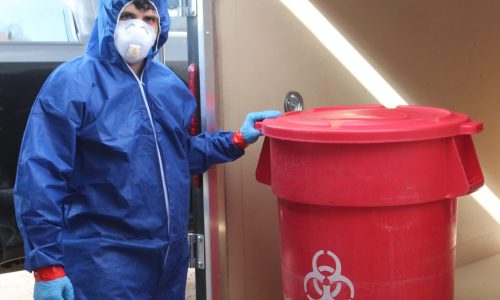
Biohazard Cleaning & Decontamination
Not all biohazardous cleaners are local to Tucson. We are and we can get there quickly. We have trained in taking care of all types of biohazard, so you can feel safe in home or work place.
- Unattended death
- Blood cleanup
- Homicide/Trauma cleanup
- Suicide cleanup
- Virus disinfecting cleanup
- Odor removal
- Sewage backup
Biohazard cleaning and decontamination refers to the process of cleaning and removing hazardous materials, pathogens, and contaminants from an area that poses a risk to human health or the environment. Biohazards can include blood, bodily fluids, infectious diseases, chemicals, and other hazardous substances.
The following are the general steps involved in biohazard cleaning and decontamination:
1. Assessment and planning: The area is assessed to determine the extent of the biohazard contamination and the appropriate cleaning and decontamination procedures required. A detailed plan is formulated, taking into account the type of biohazard, the affected surfaces, and the necessary safety precautions.
2. Personal protective equipment (PPE): Proper personal protective equipment is worn by the cleanup personnel to protect themselves from potential exposure to biohazards. This may include gloves, masks, goggles, coveralls, and respirators, depending on the nature of the biohazard.
3. Containment: The area is cordoned off and isolated to prevent the spread of contaminants to unaffected areas. This may involve setting up barriers, using plastic sheeting, or sealing off entrances and exits.
4. Removal of biohazardous materials: The cleanup team carefully removes and disposes of all biohazardous materials present in the area. This can include blood, bodily fluids, tissues, or other hazardous substances. Specialized tools and containers are used to ensure proper containment and safe disposal in accordance with regulations.
5. Cleaning and disinfection: All surfaces and objects in the affected area are thoroughly cleaned and disinfected. Specialized cleaning agents or disinfectants are used to eliminate pathogens and ensure effective decontamination. Detailed attention is given to high-touch surfaces and areas of direct contact with the biohazard.
6. Deodorization: If necessary, deodorization techniques may be employed to eliminate any unpleasant odors associated with the biohazard contamination.
7. Verification and testing: After the cleanup and decontamination process, verification and testing may be conducted to ensure that the area is free from biohazards and meets the required safety standards. This can involve sampling, laboratory testing, or using specialized equipment to assess the cleanliness and safety of the environment.
Biohazard cleaning and decontamination should be performed by trained professionals who have the expertise, experience, and proper equipment to handle hazardous materials safely. These professionals follow industry best practices, adhere to regulations, and prioritize the health and safety of individuals involved.
520-888-7563
